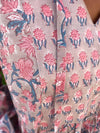
The word "desi" literally means "of the country" in Hindi. It refers to the indigenous cotton varieties of India, mainly from the botanical species Gossypium arboreum , cultivated in India for about 5,000 years, widespread in the central and southern parts of the country, and Gossypium herbaceum , native to Africa, introduced to India about 2,500 to 3,000 years ago via the maritime and caravan routes connecting the Nile Valley, the Arabian Peninsula and the Indian west coast.
These desi cottons have been adapted for thousands of years to local climates, monsoons, dry soils, and above all to agriculture without chemical inputs.
Once widely cultivated throughout India, these cottons were the basis of a local, sustainable, and circular textile system: farmers cultivated, spinners hand-spun, and weavers produced quality fabrics, sometimes of extreme fineness.
Among these cottons we will notably mention:
- Kala cotton from Kutch (Gujarat), hardy, capable of growing in arid and saline soils: nicknamed “black” (kala) not for the color of its fiber but for the dark shade of its seeds and the robustness of the plant.
- red cotton from Ponduru (Andhra Pradesh), lightly dyed naturally with plant pigments, still spun and woven today by a few artisans whose know-how is in danger of extinction.
- Wagad cotton from northern Gujarat, very close to Kala, appreciated for its ability to grow without irrigation in semi-desert areas.
- Jayadhar from Karnataka, with its naturally soft and strong thread.
- Yerrapatti from Tamil Nadu, known for its slightly longer fiber and adaptation to coastal areas.
- the Punasa of Madhya Pradesh, once prized for the fineness of its thread.
All these desi cottons have one thing in common: a short, strong fiber, ideal for hand spinning on a spinning wheel (charkha) or spindle. Hand-spun, it produces a strong, breathable thread and an incredibly soft fabric that develops a patina over time. Khadi, made famous by Gandhi, is the direct heir to this tradition.
Desi cotton, as we can see, is a story of natural resilience: its deep roots allow it to draw water from deep within, it withstands droughts, resists most local insects, and thrives in poor soils. Where modern cotton requires irrigation and chemicals, it thrives almost on its own.
And yet, it has almost disappeared. Under British colonization, the desi varieties were replaced by long-staple cottons from the American species Gossypium hirsutum adapted to the Manchester spinning mills. After independence, agricultural modernization and, later, the arrival of Bt cotton further marginalized these peasant seeds.
Traditional weavers have followed the same path: in Ponduru, for example, there are only a few families left capable of transforming the local red cotton from the field to the finished fabric. When these hands disappear, an entire knowledge will be extinguished.
Today, a renaissance movement is beginning. In Kutch, some cooperatives are helping farmers replant Kala cotton and sell it directly to weavers. In Karnataka, a few villages continue to cultivate Jayadhar. Indian and foreign designers, attentive to natural materials, are beginning to incorporate these fabrics into their collections.
But this return to the sources remains fragile.
But in the world as it is, this return to basics isn't for everyone. Kala cotton, red cotton, hand-woven fabrics... all of these require time, knowledge, and patience—and therefore cost more than mass-produced synthetic fabrics. Today, these natural and local materials, carried by artisan collectives or committed brands, are finding their place primarily in discerning circles: ethical fashion, haute couture, and consumers sensitive to ecology or heritage.
In other words, what was yesterday the peasant norm, accessible to all, is gradually becoming an elite product, reserved for those who can afford it - or know why they want it.
This is the paradox. If this renaissance is not accompanied by massive support for craftsmanship and a profound change in our consumption habits, it risks ending up as a fashion reserved for the privileged, far from the fields where it was born.
Because, beyond the price, there is a question of conscience: understanding that a garment or an accessory is not only worth its design, but also its fiber, its impact on the earth, and the hands that made it.




0 comments